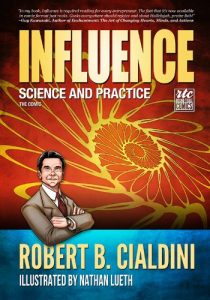Book: Influence – Science and Practice
Author: Robert Cialdini

This classic book on persuasion talks about the psychology of people and what makes them say ‘yes’. It helps to offer a deep understanding of this matter and how it can be applied in a practical scenario. The book is top tier since it is the result of more than 3 decades of extensive evidence-based research.
It covers 6 core principles that will aid in becoming a master persuader:
1. RECIPROCATION
“Try to repay, in kind, what another person has provided us.”
- Reciprocation is a powerful tool to effectively gain someone else’s compliance or favour. Practising this will present you with more ‘yeses’ than without it.
2. COMMITMENT & CONSISTENCY
- The name is self-explanatory. This principle is about staying consistent with what you have already done. People often stick to their choices or decisions due to personal and interpersonal pressures that urges them to hold to those choices.
3. SOCIAL PROOF
- Social proof is what is similar to peer pressure. This principle reflects on how we determine what is correct behaviour based on social norms.
- We do it just because others do it.
- The correctness of behaviour is perceived as the number of people doing it.
4. LIKING
- This principle points out the well-known fact that we prefer to say yes to the people we know and like. The factors that cause us to like someone else:
- Physical Attractiveness: It is another well-known fact that when we are attracted to someone else, we tend to forgo any preceding logic which we would apply otherwise and always prefer to say yes to them. Plain and simple. It could be a friend, a co-worker, a celebrity etc.
- Similarity: We are inclined to like people who are similar to us. Similarity can be derived from sharing the same personality, opinions, hobbies, lifestyle etc.
- Compliments: We enjoy getting compliments. Offering a compliment highly increases the likability of the person giving it. As a natural reaction, we tend to like such people.
- Contact: We tend to like and prefer things or people that we are familiar with. This is the reason why we continue to eat at the same restaurant instead of trying new places.
- Cooperation: We prefer and like people who work with us rather than those that work against us. Co-workers working to achieve a common goal is a good example. We perceive it as being on the same team.
- Conditioning and Association: This is principle covers the general idea of why we prefer to associate ourselves with winners/positive events as this gives us a boost in social standing. This can be both good and bad.
5. AUTHORITY
- We tend to follow people in uniform or people in authority. Pretty simple.
6.SCARCITY
- This explains the core principle that opportunities seem to be more valuable when it’s availability is very scarce.
Key Takeaways:
1. The six principles of influence: reciprocity, commitment and consistency, social proof, liking, authority, and scarcity.
2. The power of social proof and how it can be used to influence others’ behavior.
3. The importance of building and maintaining relationships in order to influence others.
4. The role of authority and how it can be used to persuade others.
5. The concept of scarcity and how it can be used to create a sense of urgency and increase the perceived value of something.
Practical Application:
1. In sales and marketing, understanding the principles of influence can help in creating effective campaigns and persuading potential customers.
2. In negotiations, using the principle of reciprocity can help in building trust and reaching mutually beneficial agreements.
3. In leadership, understanding the principles of influence can help in motivating and influencing team members to achieve goals.
4. In customer service, using the principle of liking can help in building rapport and creating positive experiences for customers.
Valuable Insights for Leaders and Managers:
1. Chapter 3: “Commitment and Consistency” – This chapter discusses the power of commitment and how it can be used to influence others’ behavior.
2. Chapter 5: “Liking” – This chapter explores the factors that contribute to liking and how it can be used to influence others.
3. Chapter 6: “Authority” – This chapter delves into the concept of authority and how it can be used to persuade others.
4. Chapter 7: “Scarcity” – This chapter discusses the impact of scarcity on people’s decision-making and how it can be used to influence behavior.
Effective Case Studies and Examples:
1. The Milgram experiment – This study demonstrates the power of authority and how it can influence individuals to act against their own moral code.
2. The Cialdini Method – This case study showcases how the principles of influence were used to increase organ donation rates.
3. The Tupperware party – This example illustrates the power of social proof and how it can be used to influence purchasing decisions.
4. The “limited time offer” tactic – This example demonstrates the use of scarcity to create a sense of urgency and increase sales.
Overall, Influence – Science and Practice offers valuable insights and practical strategies for individuals in leadership and management roles. By understanding and applying the principles of influence, one can effectively persuade and influence others in various real-world scenarios. The book also provides compelling case studies and examples that illustrate the principles in action.
Leave a Reply